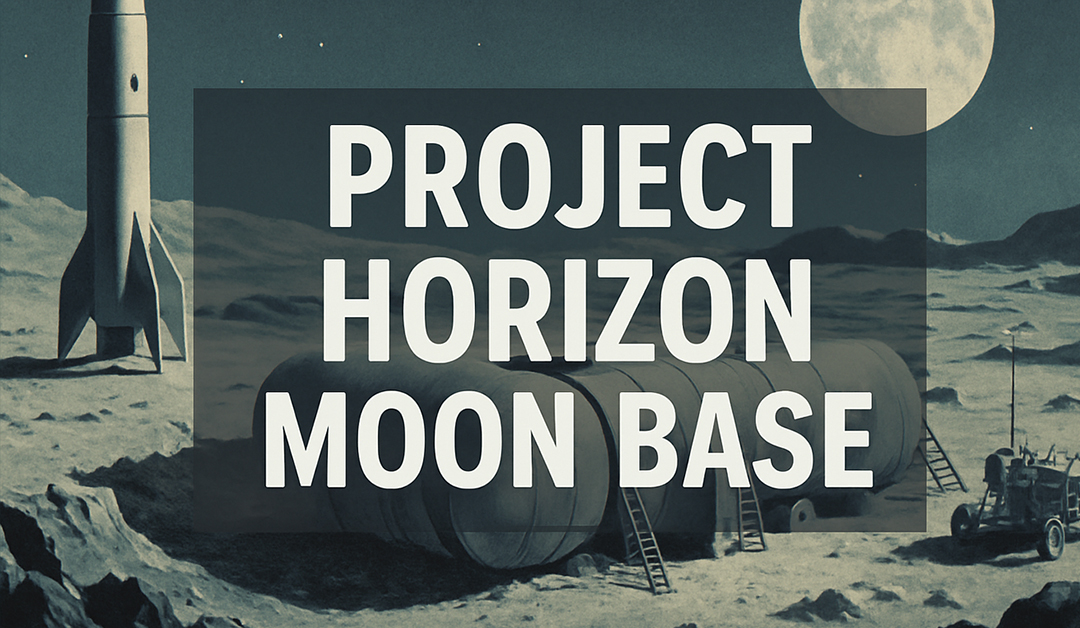In 1959, while the public marveled at early space probes and Sputnik-induced panic, the United States Army quietly developed a sweeping plan to establish a permanent military outpost on the Moon.
It wasn’t science fiction. It was Project Horizon-a classified feasibility study proposing construction of a lunar base to be operational within a decade.
The documents, now declassified, show the Army’s intention was clear: to stake an American military claim on the Moon before the Soviets could.
“To be second to the Soviet Union in establishing an outpost on the Moon would be disastrous to our nation’s prestige.”
🧱 A Manhattan Project in Space
The Army’s internal documents repeatedly liken Project Horizon to the scale and urgency of the WWII Manhattan Project. The Moon base, envisioned to support 12 military personnel, would include:
-
Buried living quarters made of modular metal tanks
-
On-site nuclear power reactors
-
Earth-to-Moon and Moon-to-space surveillance and communications systems
-
The capability for weapons deployment
The base would serve as a launch point for deeper space missions, a relay for military communications, and-if necessary-a platform for hostile engagement.
🚀 How It Would Work
The transportation system relied on Saturn I and II rockets-the precursors to the Saturn V. The Army proposed a construction phase starting in 1965, with cargo landings and crew arrivals by 1966. Over 200 launches would ferry everything from nuclear generators to water recyclers.
To survive on the Moon, the outpost would:
-
Be dug underground to protect from radiation and meteoroids
-
Use suits made with reflective, pressurized metal shells
-
Recycle oxygen and water from the lunar environment
-
Eventually host hydroponic gardens and closed-loop life support
📡 Lunar Surveillance and Military Edge
Beyond prestige, the real edge was surveillance and control:
-
Earth observation using triangulation from the Moon
-
Space vehicle tracking and early-warning radar systems
-
Military deterrence from a location impossible to strike preemptively
“Moon-based military power will be a strong deterrent to war because of the extreme difficulty, from the enemy point of view, of eliminating our ability to retaliate.”
🛰️ What If the Soviets Got There First?
The fear wasn’t just Soviet exploration-it was Soviet territorial claim. Horizon’s authors warned that if the USSR established a base, they could:
-
Deny U.S. access to key Moon locations
-
Claim sovereign control under emerging “space law”
-
Establish weapons systems out of reach of Earth-based defenses
Their language was blunt:
“The Soviet Union… may claim the moon or critical areas thereof for its own.”
🧪 Politics, Power, and the Void
Horizon wasn’t just about strategy-it was about narrative. To the U.S. Army, letting the Soviets win the Moon would permanently damage America’s claim to space leadership. The Moon was framed not just as a scientific frontier, but as a test of ideological dominance.
“Once having been second best in the eyes of the world’s population, we are not now in a position to afford being second on any other major step in space.”
Project Horizon was ultimately shelved, as NASA took over the mantle of U.S. spaceflight and the military ambitions were downplayed for public optics.
But the plan itself-comprehensive, detailed, and technically sound-remains a sobering look at how close the Moon came to becoming a battlefield instead of a symbol of peace.






